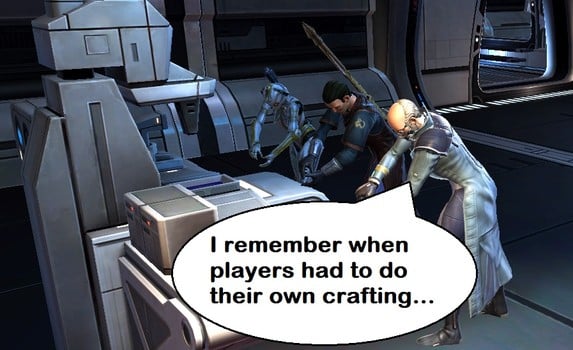Welcome to the expansive universe of “Star Wars: The Old Republic” (SWTOR), where the art of crafting and the nuances of the game’s economy play pivotal roles in your journey across the galaxy. Whether you’re a seasoned veteran looking to maximize your economic impact or a newcomer eager to understand the basics of crafting and trading, this guide is designed to equip you with the knowledge and strategies necessary to thrive in SWTOR’s vibrant economic ecosystem. As you embark on this comprehensive exploration, you’ll be introduced to key concepts and practical tips that cover every aspect of SWTOR’s economy, including:
- Overview of SWTOR’s Economy: Understanding the player-driven market and the role of credits as the primary currency.
- The Crafting System Explained: A deep dive into the Crew Skills system, highlighting the synergy between Gathering, Crafting, and Mission skills.
- Tips for Effective Crafting: Strategies for selecting the right Crew Skills, conducting market research, and crafting items that ensure both personal and economic benefits.
- Managing Your Credits: Essential advice on budgeting, earning, and spending credits wisely to maximize your financial growth and in-game progress.
- Mastering the Galactic Trade Network (GTN): Insights into successful trading practices, including timing, pricing strategies, and trend analysis to optimize your sales and purchases.
- Exploiting Gathering Skills: How to leverage Gathering and Mission skills like Slicing for direct income and valuable materials.
- Crafting for Profit and Utility: Balancing the creation of items for personal use with crafting goods for sale to ensure a steady stream of income.
- Navigating Market Fluctuations: Techniques for adapting to and capitalizing on the dynamic nature of SWTOR’s market, ensuring you stay ahead of economic trends and changes.
By the end of this guide, you’ll have a solid foundation in the mechanics of SWTOR’s economy, from the intricacies of crafting to the strategic trading and management of credits. Whether your goal is to craft the finest gear for your characters, dominate the GTN, or simply enjoy the game with a healthy bank balance, the insights provided here will help you achieve economic success and enhance your overall experience in the galaxy far, far away. Let’s embark on this journey through the economic landscape of “Star Wars: The Old Republic,” where fortune and adventure await.
Understanding the Economy
The economy in “Star Wars: The Old Republic” (SWTOR) is a complex and dynamic system, driven by the actions and interactions of thousands of players across the galaxy. At its core, SWTOR’s economy is built around the acquisition, consumption, and trading of goods and services, with credits serving as the primary currency. Understanding the nuances of this economy is crucial for any player looking to make their mark, whether through crafting, trading, or simply managing their resources effectively. Here, we’ll delve deeper into the foundational elements of SWTOR’s economy, exploring how it functions and how you can engage with it to your advantage.
The Role of Credits
Credits are the lifeblood of SWTOR’s economy, facilitating trade between players and serving as the primary means of acquiring goods and services. From purchasing gear and crafting materials to securing a ride on a taxi or buying a new starship, credits are essential for virtually every aspect of life in the galaxy.
- Earning Credits: Players can earn credits through a variety of activities, including completing quests, selling items, performing successful trades on the Galactic Trade Network (GTN), and participating in group missions or events.
- Spending Credits: Wise spending is as important as earning. Investing in upgrades for your character, purchasing necessary crafting materials, or saving for high-value items are all strategic decisions that can impact your gameplay.
The Galactic Trade Network (GTN)
The GTN is SWTOR’s player-driven marketplace, where individuals can buy and sell goods ranging from rare crafting materials to powerful gear. Understanding how to effectively use the GTN is essential for any player looking to profit from the economy.
- Supply and Demand: The GTN operates on the basic economic principle of supply and demand. Prices fluctuate based on the availability of items and the current market demand, making timing and market research crucial for successful trading.
- Listing Fees and Taxes: When selling on the GTN, players are charged a listing fee and a sales tax upon the successful sale of an item. Factoring these costs into your pricing strategy is important for maintaining profitability.
Crafting’s Role in the Economy
Crafting in SWTOR is not just about creating items for personal use; it’s also a vital part of the game’s economy. Players who master crafting can produce goods that are in high demand on the GTN, turning their skills into a significant source of income.
- Crafting for Profit: Identifying items that are in high demand but low supply can lead to lucrative crafting opportunities. Keeping an eye on market trends and player needs can help crafters choose which items to produce.
- Material Sourcing: Successful crafters know the importance of efficiently sourcing materials, whether through gathering skills, purchasing from the GTN, or utilizing mission skills to acquire rare components.
Participating in the Economy
Engaging with SWTOR’s economy requires a balance of earning, spending, and investing credits, as well as understanding and leveraging the GTN for both purchasing and selling.
- Diversifying Income Streams: Don’t rely solely on one method of earning credits. Combining quest rewards, crafting, GTN trading, and participating in events can ensure a steady flow of income.
- Market Watching: Regularly monitoring the GTN can provide insights into which items are selling well and at what price, helping you adjust your strategies accordingly.
Conclusion
Understanding and engaging with the economy in “Star Wars: The Old Republic” is a multifaceted endeavor that encompasses earning credits, crafting, trading, and more. By mastering these aspects, players can enhance their gameplay experience, ensuring they have the resources needed to succeed in their galactic adventures. Whether you’re a crafter looking to dominate the market, a trader playing the GTN, or simply a player looking to manage your credits wisely, a deep understanding of SWTOR’s economy is an invaluable tool in your journey across the stars.
Crafting System
The crafting system in “Star Wars: The Old Republic” (SWTOR) is an integral part of the game that allows players to create a wide array of items, including but not limited to gear, weapons, and consumables. This system is driven by what’s known as Crew Skills, a collection of abilities that your companions can perform on your behalf. Understanding how to leverage these skills effectively can not only enhance your gameplay experience but also provide a significant source of income. Let’s delve deeper into the nuances of the crafting system, exploring the Crew Skills in more detail and offering strategies to maximize their potential.
Crew Skills Overview
In SWTOR, each player can select up to three Crew Skills, which are divided into three categories: Gathering, Crafting, and Mission skills. These skills allow you to gather resources, create items, and send companions on missions to obtain various goods.
Gathering Skills
Gathering skills are essential for acquiring the materials needed for crafting. They include:
- Archaeology: Collects artifact fragments and power crystals used in Artifice and Synthweaving.
- Bioanalysis: Harvests genetic material from creatures and plants, used in Biochem crafting.
- Scavenging: Retrieves useful materials from old or damaged technology, crucial for Armormech, Armstech, and Cybertech crafting.
- Slicing: Unlocks safes and data stations to obtain rare items, schematics, and credits.
Crafting Skills
Crafting skills enable you to create a variety of items. Each crafting skill produces different types of items:
- Armormech: Focuses on crafting personal armor for non-Force users.
- Armstech: Specializes in the creation of weapons such as blasters and modifications.
- Artifice: Produces Force-user equipment, including lightsabers and enhancements.
- Biochem: Creates consumable items like medpacs, stims, and adrenals.
- Cybertech: Engineers earpieces, ship upgrades, and gadgets.
- Synthweaving: Crafts wearable gear for Force users.
Mission Skills
Mission skills are unique in that they involve sending companions on missions to gather resources or information:
- Diplomacy: Gathers medical supplies and companion gifts, also affecting your Light or Dark side alignment.
- Investigation: Obtains rare crafting materials and schematics for various crafting skills.
- Treasure Hunting: Finds rare items, gems, and companion gifts.
- Underworld Trading: Secures luxury fabrics and metals, essential for certain crafting professions.
Maximizing Your Crafting Potential
To truly excel in SWTOR’s crafting system, consider the following strategies:
- Choose Complementary Skills: Pairing crafting skills with the appropriate gathering and mission skills can significantly streamline your crafting process. For example, coupling Artifice with Archaeology ensures a steady supply of necessary materials.
- Market Research: Before crafting items for sale, investigate the Galactic Trade Network (GTN) to identify which items are in demand. This research can guide you in deciding what to craft for profit.
- Optimize Companion Usage: Your companions are your most valuable asset in crafting. Each companion has specific bonuses to certain Crew Skills. Assigning them tasks that align with these bonuses can increase efficiency and yield better results.
- Craft While Questing: Crafting doesn’t have to halt your adventuring. You can send companions on gathering or mission tasks while you’re questing, ensuring that your crafting endeavors continue unabated.
- Utilize Work Orders: Work orders allow you to craft multiple items at once. This is especially useful when you’re mass-producing items for sale or stockpiling consumables for personal use.
- Stay Updated: The SWTOR economy and player needs can shift with new content updates and expansions. Regularly updating your knowledge of what’s in demand can help you stay profitable and relevant in the crafting market.
Conclusion
Crafting in “Star Wars: The Old Republic” is a deeply engaging and potentially lucrative aspect of the game. By carefully selecting and managing your Crew Skills, conducting thorough market research, and efficiently utilizing your companions, you can become a crafting master. Whether your goal is to equip your characters with the best possible gear or to carve out a niche for yourself in the galactic economy, mastering the crafting system is a step towards achieving greatness in the vast universe of SWTOR.
Tips for Crafting
Crafting in “Star Wars: The Old Republic” (SWTOR) offers a pathway not only towards self-sufficiency but also towards potentially lucrative economic ventures. To excel in SWTOR’s crafting system, it’s essential to approach it with strategy and foresight. Below are expanded tips and strategies designed to elevate your crafting game, ensuring you make the most of your time and resources.
1. Plan Your Crafting Journey
- Research Before You Choose: Before diving into crafting, take the time to research which Crew Skills align best with your character’s needs or your economic goals. Some crafting skills synergize better with certain classes or playstyles.
- Align Crew Skills with Your Goals: Decide early on if your focus is on gearing up your characters, selling goods on the Galactic Trade Network (GTN), or perhaps a mix of both. This decision can guide which Crew Skills you should prioritize.
2. Efficiently Gather Resources
- Optimize Gathering Routes: When exploring planets, plan your routes to pass through areas rich in gathering nodes. This efficiency will save time and increase your material stockpile without much extra effort.
- Use Companions Wisely: Assign your companions to gather resources while you’re engaged in missions or other activities. Matching the right companion with the appropriate gathering task can yield better results due to their unique bonuses.
3. Master the Market
- Understand Supply and Demand: Keep a close eye on the GTN to understand which items are in high demand. Crafting items that are currently sought after can significantly increase your profit margins.
- Timing is Everything: Pay attention to game events or updates that might increase demand for specific items. Crafting and selling these items at the right time can lead to substantial earnings.
4. Craft Smart, Not Hard
- Batch Production: Utilize work orders to craft multiple items simultaneously. This approach not only saves time but also allows you to fill inventory slots on the GTN more efficiently.
- Quality Over Quantity: Focus on crafting items that offer higher profit margins rather than mass-producing items with lower returns. This strategy often means targeting high-level or endgame content items.
5. Invest in Rare Schematics
- Seek Out Rare Recipes: Rare schematics can produce items that are much more valuable in the SWTOR economy. These can be obtained through various means, including mission skills like Investigation or by participating in certain in-game activities.
- Experiment With Customizations: Items that offer aesthetic value or customization, such as armor dyes or unique weapon appearances, can also fetch a high price, appealing to players looking to personalize their characters.
6. Develop a Crafting Specialty
- Become the Go-To Crafter: Specializing in a niche market can establish you as the go-to crafter for specific items. This reputation can lead to direct requests from other players, bypassing the GTN entirely.
- Stay Informed: Game updates can affect crafting dynamics significantly. Stay informed about changes to your specialty area to adapt quickly and maintain your market position.
7. Utilize Your Legacy
- Expand Your Crafting Empire: Utilize alts (alternate characters) to cover more crafting specialties. SWTOR’s Legacy system allows for easier management of multiple characters, enabling you to dominate various market segments.
- Share Resources Across Characters: The Legacy Bank is an invaluable tool for sharing resources and crafted items among your characters, streamlining the crafting process across your entire account.
8. Networking and Collaboration
- Join a Crafting Guild: Being part of a crafting-focused guild can provide access to resources, shared knowledge, and a built-in market for your goods.
- Collaborate with Other Crafters: Sometimes, crafting certain items requires materials or sub-components from other crafting professions. Building relationships with other crafters can facilitate these exchanges, benefiting all parties involved.
Conclusion
Crafting in SWTOR is a complex but rewarding endeavor. By applying these detailed tips—from planning and gathering to crafting with precision and understanding the market—you can turn your crafting efforts into a significant source of gear for your characters and income for your in-game ventures. Remember, the key to successful crafting lies not only in what you make but also in how you make it, market it, and manage the resources at your disposal. With patience, strategy, and a bit of entrepreneurial spirit, you’ll find crafting in SWTOR to be both a profitable and fulfilling part of your galactic journey.
Managing Credits
In “Star Wars: The Old Republic” (SWTOR), managing your credits effectively is crucial for both new and veteran players. Credits are the backbone of your economic activities, from gearing up for battles to investing in crafting or trading on the Galactic Trade Network (GTN). Efficient credit management can enhance your gameplay experience by providing the resources needed to participate in higher-level content, craft or purchase top-tier gear, and even decorate your stronghold. Here’s an extended guide on managing your credits wisely in SWTOR.
1. Earning Credits Efficiently
- Questing and Missions: Regularly completing quests and missions is a steady source of credits. Don’t overlook daily and weekly missions, which can be particularly lucrative.
- Participate in Flashpoints and Operations: These group activities not only offer a change of pace from solo play but also provide substantial credit rewards and valuable loot that can be sold.
- Maximize Your Gathering Skills: Skills like Slicing are directly tied to earning credits. Make it a habit to slice terminals you encounter during your adventures.
- Sell Unwanted Items: Keep your inventory clean by selling unwanted items to vendors or on the GTN. Even seemingly insignificant items can accumulate to a significant amount of credits over time.
2. Spending Credits Wisely
- Prioritize Necessary Purchases: Invest in items that will have a long-term benefit for your character, such as inventory expansions, rather than spending on temporary boosts or cosmetic items early on.
- Use the GTN to Buy Gear: Sometimes, purchasing gear from the GTN can be more cost-effective than trying to craft it, especially if materials are expensive or scarce.
3. Investing in the Future
- Invest in Crew Skills: Certain crew skills can be a significant source of income, whether through crafting high-demand items or gathering rare materials to sell.
- Save for High-Value Items: Some items, like rare mounts or legacy gear, can save you credits in the long run. Saving up for these items instead of making small, unnecessary purchases can be more rewarding.
4. Mastering the GTN
- Understand Market Trends: Keep an eye on the GTN to understand pricing trends. Buying low and selling high can net you a profit with little effort.
- Specialize in Niche Markets: Focusing on specific items or materials can make you an expert in that market, allowing you to predict trends and know the best times to buy or sell.
5. Credit Management Strategies
- Set a Budget: Keep track of your income and expenses. Setting a weekly or monthly credit budget can help you manage your spending and saving habits more effectively.
- Create a Savings Goal: Whether it’s a rare item or simply a financial cushion, having a savings goal can motivate you to manage your credits more judiciously.
- Utilize Alts: Use alternate characters to spread your economic activities. This can include specializing in different crew skills or accessing different markets.
6. Avoiding Common Pitfalls
- Beware of Scams: Always be cautious when trading with other players. If a deal seems too good to be true, it probably is.
- Resist Impulse Buying: With so many tempting items available, it’s easy to make impulsive purchases. Take a moment to consider if you really need an item before buying.
7. Utilizing Credit Bonuses
- Take Advantage of Events: Certain events offer increased credit rewards. Participating in these events can be a great way to boost your income.
- Use Credit Boosts: Credit boosts can be obtained through gameplay or purchased from the Cartel Market. Using these at the right time, such as during high-reward missions or events, can significantly increase your earnings.
Conclusion
Managing credits in SWTOR is about finding a balance between earning, spending, and saving. By employing these strategies, players can ensure they have the resources needed to enjoy all aspects of the game, from participating in endgame content to indulging in the galactic economy. Remember, the goal is to make the economy work for you, not the other way around. With careful planning and strategic thinking, you’ll find that managing your credits becomes second nature, allowing you to focus on enjoying the vast universe of SWTOR.
Trading on the Galactic Trade Network (GTN)
The Galactic Trade Network (GTN) is the central hub for player-to-player transactions in “Star Wars: The Old Republic” (SWTOR). Mastery of the GTN can lead to substantial in-game wealth, allowing players to afford the best gear, rarest items, and even coveted stronghold decorations. To truly excel in trading on the GTN, a comprehensive understanding of market dynamics, buyer behavior, and strategic listing practices is necessary. This extended guide will delve into advanced strategies and tips for maximizing your success on the GTN.
Understanding the GTN’s Mechanics
- Regional Markets: The GTN is divided into regional markets, meaning that listings are specific to your server. Understanding your server’s economy—such as peak playing times and the demand for specific items—can significantly impact your trading success.
- Listing Duration and Fees: When listing an item on the GTN, you can choose different durations, each with its own cost. It’s crucial to balance the listing fee against the potential for a quicker sale.
Advanced Trading Strategies
- Market Research: Regularly scan the GTN to identify undervalued items that can be resold for a profit. Also, note which high-value items are in demand but low supply, indicating a profitable crafting or gathering opportunity.
- Specialization: Becoming an expert in specific types of items (e.g., endgame gear, crafting materials, or rare mounts) can make your trading efforts more efficient. Specialization allows for deeper market knowledge and quicker identification of profitable opportunities.
- Bulk Buying and Selling: Purchasing items in bulk during low-demand periods and selling them individually during high-demand times can yield significant profits. This tactic requires substantial initial capital and storage but can be highly lucrative.
- Seasonal Trading: Pay attention to in-game events or updates, as these can significantly affect item demand. For example, items related to Life Day or in-game anniversaries may spike in price around those times.
Listing and Pricing Items
- Competitive Pricing: Always price your items competitively. This doesn’t necessarily mean being the cheapest; rather, it means pricing your items according to their value and demand, factoring in the rarity and desirability.
- Dynamic Pricing: The GTN is a dynamic market. Adjust your prices based on current trends, competition, and your urgency to sell. Regularly check your listings and adjust prices to stay competitive.
- Psychological Pricing: Consider using psychological pricing strategies, such as listing an item for 999,999 credits instead of 1 million. These slightly lower prices can make items more appealing to buyers.
Maximizing Profit Margins
- Cost Analysis: For crafters and gatherers, always perform a cost analysis to ensure that the sale price of your crafted or gathered items exceeds the cost of materials and listing fees. Factor in your time as a cost to ensure that your trading activities are economically viable.
- Utilize Alt Characters: Use alt characters to spread out your listings and cover more market segments. Alts can also serve as additional storage and specialize in different crew skills to diversify your income streams.
Navigating Market Fluctuations
- Stay Informed: Keep abreast of game updates, expansions, and community trends. New content can shift the market dramatically, creating opportunities for prepared traders.
- Flexibility: Be prepared to pivot your trading strategy based on market conditions. Flexibility and adaptability are key to staying profitable amidst market fluctuations.
Engaging with the Community
- Community Insight: Participate in forums and social media groups related to SWTOR. Insights from the community can tip you off to emerging trends and hot items.
- Reputation Building: Establishing a reputation as a reliable and fair trader can lead to direct sales outside the GTN, reducing fees and increasing profits.
Conclusion
Trading on the Galactic Trade Network is both an art and a science, requiring a keen understanding of market dynamics, strategic pricing, and buyer behavior. By applying these advanced strategies and maintaining a flexible, informed approach to trading, players can significantly enhance their economic standing in “Star Wars: The Old Republic.” Remember, successful trading isn’t just about making credits—it’s about making smart decisions that capitalize on the ever-changing landscape of the galaxy’s economy.
Conclusion
Mastering the Galactic Trade Network (GTN) in “Star Wars: The Old Republic” (SWTOR) is an endeavor that challenges players to apply both strategic insight and market intuition. The GTN is not just a tool for financial gain; it is a dynamic component of the game that reflects the collective actions of its player base, offering a unique way to engage with the economy of the galaxy. By delving into the complexities of trading, players can unlock new levels of gameplay satisfaction, turning market activities into a rewarding aspect of their SWTOR experience.
Beyond Credits: The Broader Impact of GTN Mastery
- Community Engagement: Successful traders often become well-known figures within their server communities, providing market stability and contributing to the economic health of the game. Engaging with the community through forums, social media, or in-game guilds can enhance your understanding of market needs and foster connections that go beyond simple transactions.
- Strategic Advantages: Mastery of the GTN can provide strategic advantages in other areas of the game. Access to better gear, rare items, and crafting materials can significantly impact your performance in PvE, PvP, and endgame content. Moreover, a strong economic foundation allows for greater experimentation with character builds and playstyles, enriching your overall gameplay experience.
- Personal Growth and Satisfaction: Navigating the GTN successfully requires patience, analysis, and adaptation—skills that are valuable both in-game and in real-life scenarios. The sense of achievement from predicting market trends, making profitable trades, or even manipulating market segments provides a deep sense of satisfaction and personal growth.
The Future of Trading in SWTOR
As SWTOR continues to evolve, with new expansions and updates regularly introduced, the GTN will also change. New items, crafting materials, and consumables will shift the economic landscape, presenting fresh challenges and opportunities for traders. Staying informed and adaptable is key to maintaining your edge in the market. Embrace the changes as opportunities to learn, grow, and possibly redefine your trading strategies.
Final Words of Advice
- Keep Learning: The most successful traders never stop learning. They continuously explore new market segments, experiment with different trading strategies, and learn from both successes and failures.
- Balance and Diversification: Avoid putting all your credits into one market segment. Diversify your investments to mitigate risks and take advantage of multiple income streams.
- Enjoy the Journey: While mastering the GTN can be financially rewarding, remember to enjoy the journey. SWTOR offers a rich, immersive experience that goes beyond credits and transactions. Engage with the stories, explore new worlds, and immerse yourself in the vast Star Wars universe.
In conclusion, mastering the GTN in SWTOR is a complex, rewarding process that extends far beyond mere credit accumulation. It offers an opportunity to engage with the game on a deeper level, impacting not just your own gameplay experience but also contributing to the vibrancy and dynamism of the wider game community. Whether you’re a casual trader looking to fund your adventures or a market mogul aiming to dominate the economy, the GTN presents a galaxy of opportunities waiting to be explored.







